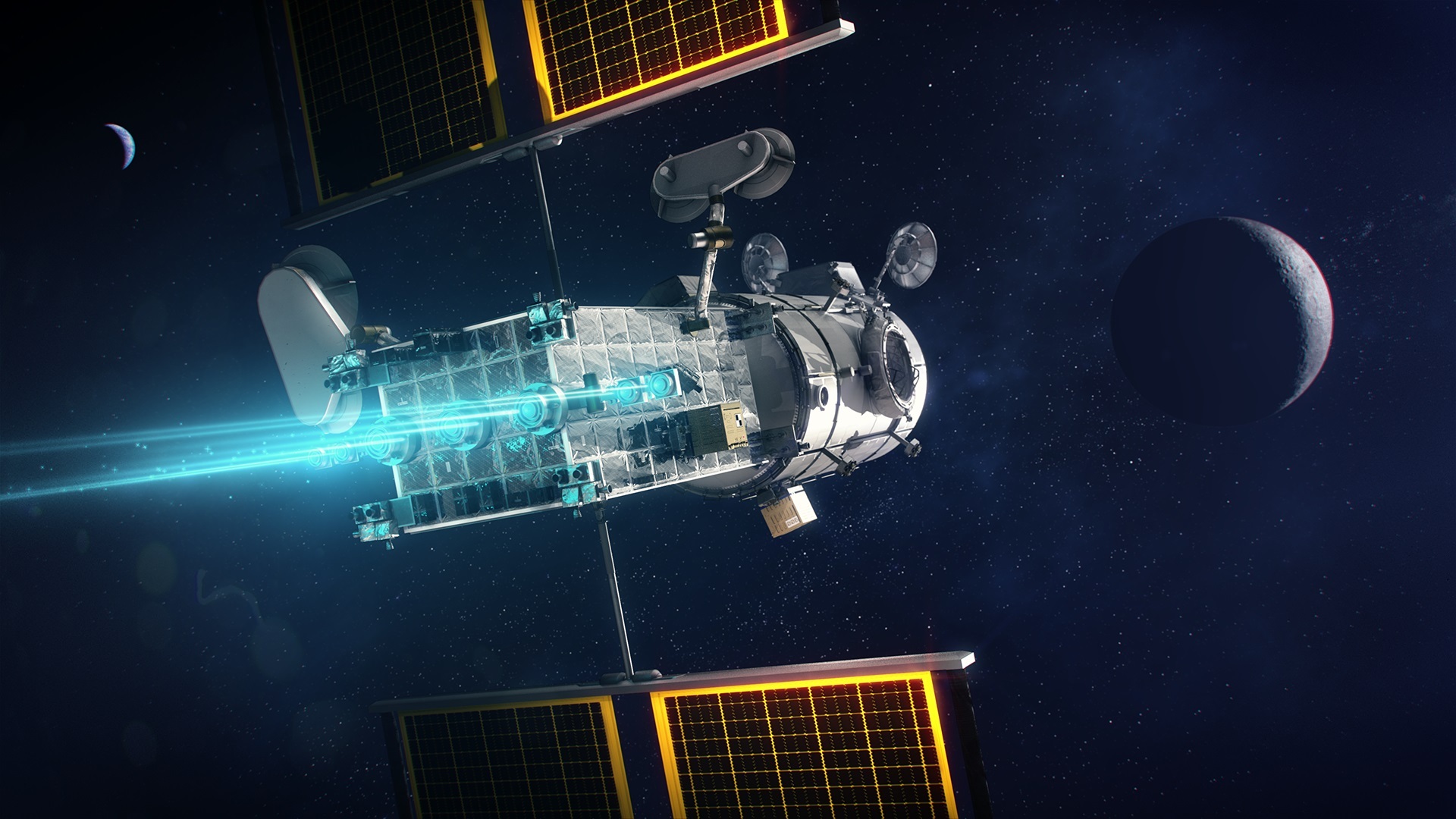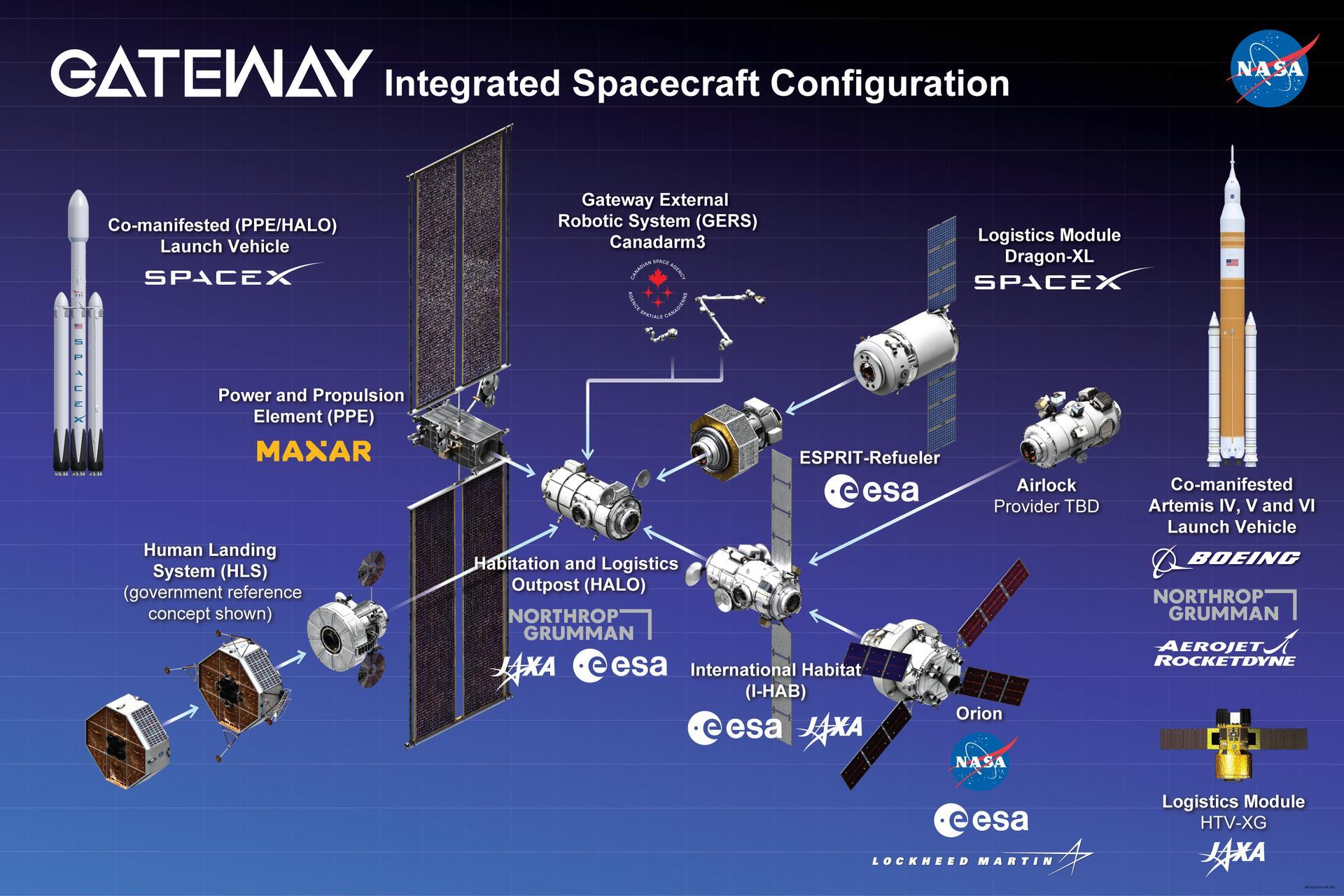25.05.2024

The two elements that will make up the initial Gateway capability for NASA’s Artemis campaign are getting ready for systems installations this year and next year, as the space agency reviews progress to set a new launch date. The Power and Propulsion Element (PPE) and Habitation and Logistics Module (HALO) are being constructed on different continents for eventual launch together as the Gateway’s co-manifested vehicle (CMV).
NASA announced that the previously scheduled launch of the CMV in September 2025 would be delayed; a new estimate is still being worked, but the conservative baseline commitment to Congress estimated it might be as late as December 2027. Meanwhile, Maxar is ready to begin PPE hardware installations, and HALO is now expected to arrive at Northrop Grumman’s Gilbert, Arizona, facilities by the end of the year.
Initial elements completing structural assembly, beginning systems integration
The Gateway will be a lunar space station that serves as a staging point for Artemis crews on the way to the surface of the Moon. Orion crews will rendezvous and dock with Gateway in its special Near Rectilinear Halo Orbit (NRHO) before they transfer to a SpaceX or Blue Origin lunar landing spacecraft already at Gateway to head to the south pole of the Moon.
The space station will be utilized differently than the International Space Station (ISS) in low-Earth orbit. The ISS has been permanently crewed since the beginning of the century, but Gateway is only meant to be crew-tended and will operate uncrewed for much of its in-space life.
The PPE and HALO elements will launch together on a Falcon Heavy rocket to begin Gateway operations, but the big question for several years is when that launch will be.
An update recently provided by NASA notes the PPE element structure was ready for installation of propulsion system components. Two pairs of propellant tanks were delivered to prime contractor Maxar and are in final preparations for installation. Installation of a pair of bi-propellant tanks and a pair of Xenon composite overwrapped pressure vessels (COPV) was forecast to begin this month.
The Xenon tanks will supply the PPE’s solar electric propulsion (SEP) systems. The development of high-power SEP thrusters has been a pacing item for PPE.
The Advanced Electric Propulsion System (AEPS) thrusters developed by Aerojet Rocketdyne are now going through environmental qualification testing. NASA said that vibration testing is complete and will be followed by qualification shock and thermal vacuum testing. The thruster environmental qualification test campaign is now forecast to be completed by the end of the year.

Plans are for the first of three flight thrusters to be delivered to Maxar early next year for subsequent installation on the spacecraft.
Three AEPS thrusters and four Busek BHT-6000 thrusters will provide the solar electric propulsion for PPE. NASA says that the qualification test campaign for those thrusters is underway and the four flight units are expected to be delivered to Maxar early next year.
The space agency says that PPE’s standalone critical design review (CDR) was held in March.
The other element of the co-manifested vehicle is the HALO module. Originally designed to be a standalone spacecraft that would be launched to intercept the Moon and would then rendezvous and dock with PPE in the Gateway orbit, NASA decided in early 2020 to essentially dock the vehicles on the ground first and launch them together.
The HALO design was modified to delete the standalone spacecraft elements and keep the habitation module ones. NASA says that the HALO CDR was completed in June 2023.
The structure of the module is currently at a Thales Alenia Space facility in Turin, Italy, where welding was completed in the fall of 2023. The structure is now going through structural stress testing before a planned shipment from Italy to prime contractor Northrop Grumman’s facility in Gilbert, Arizona, sometime in the second half of this year.
Once the module structure is delivered, integration of fluid tubing and wiring and installation of subsystems will begin.
NASA working to set a target launch date, conservative baseline estimates launch in December 2027
The two elements will fly together and the critical design review for the integrated spacecraft is also now planned for the second half of 2024. A fully expendable Falcon Heavy launch vehicle will insert the CMV into a 200 by 33,700 km highly elliptical Earth orbit.
The PPE will then begin a SEP-powered transfer from that insertion orbit to the Moon. The spiral out to NRHO is expected to take a little over a year to complete.
The target launch date for the CMV is currently undefined. When NASA announced delays to the Artemis II and Artemis III launch dates in January, the space agency also announced that the previous target for the Gateway launch of October 2025 was under review. Reports from the Government Accounting Office (GAO) have noted delays to the PPE and HALO schedules, so a delay was not unexpected; however, a new target date has not been provided.
A conservative estimate was provided as a part of the program life cycle Key Decision Point-C (KDP-C) review. That review was completed in 2023 and agency baseline commitments were disclosed with the Fiscal Year 2025 budget request documents. “Gateway Initial Capability was approved with a baseline development cost of $3,562 million and a baseline schedule milestone of Launch Readiness Date (LRD) in December 2027 at a joint confidence
level of 70 percent,” the Congressional justification document published on March 11 said.
NASA mentioned a disclaimer when announcing these cost and schedule baselines, particularly the scheduled dates, saying the budget document: “[Joint confidence level assessments] are used to track program performance. NASA continues to manage to a more aggressive schedule.”
Historically, pioneering projects and programs, particularly in human spaceflight, have tended to see their schedules delayed.
The Gateway will begin supporting the Moon to Mars programs beginning with the Artemis IV mission, currently scheduled for no earlier than September 2028. Artemis IV is planned as both a Gateway assembly mission and a lunar landing mission. NASA’s Space Launch System rocket will launch Orion with the international habitation module (I-Hab).
According to the European Space Agency (ESA), welding of the I-Hab module structure should begin early in the last quarter of 2024, with completion planned for October 2025. Welding of the Lunar View module, previously known as the European System Providing Refueling Infrastructure and Telecommunication (ESPRIT) Refueling Module (ERM), is expected to begin in that same October 2025 timeframe; that module will be launched to the Gateway on the Artemis V mission currently scheduled for no earlier than March 2030.
(Lead image: The Gateway co-manifested vehicle is depicted in transit to the Moon in this artistic graphic. Credit: NASA)
Quelle: NSF
